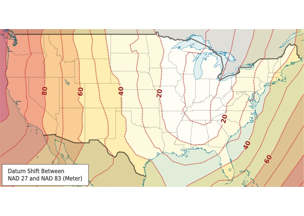WGS84 = NAD83, right?
The short answer is no, not today. The realizations of both of these reference frames have evolved over the years.
World Geodetic System 1984 (WGS84) has been used by the U.S. Military since January 21, 1987. However, there have been six realizations of WGS84 since then. While WGS84 has always been the basis for the GPS Navigation message computations, the particular version of the datum has changed. As of this writing, the latest realization of WGS84 is WGS84 (G1762). That pesky alphanumeric in the parentheses indicates the GPS week during which the coordinates first were used in the National Geospatial Intelligence Agency (NGA) precise ephemeris estimations. Therefore, coordinates provided today by GPS receivers are based in WGS84 (G1762), which is the sixth update to the realization of the WGS84 Reference Frame.
The original WGS 84 was based on observations from more than 1900 Doppler Stations. It was revised to become WGS84 (G730) to incorporate GPS observations. That realization was implemented in GPS by the Operational Control Segment (OCS) on June 29, 1994. More GPS based realizations of WGS84 followed, WGS84 (G873) on January 29, 1997, and WGS84 (G1150) was implemented on January 20, 2002 and WGS84 (G1674) on February 8, 2012. Today the epoch of WGS84 is (G1762).
While a committee of the National Academy of Sciences advocated the need for a new adjustment in its 1971 report, work on the new North American Datum 1983 (NAD83) to supersede the North American Datum 1927 (NAD27) did not really begin until after July 1, 1974. Leading the charge was the National Geodetic Survey (NGS). The NGS and the Geodetic Survey of Canada set about the task of attaching and orienting the GRS80 ellipsoid to the actual surface of the earth, as it was defined by the best positions available at the time.
It took more than 10 years to readjust and redefine the horizontal coordinate system of North America into what is now NAD83. More than 1.7 million weighted observations derived from classical surveying techniques throughout the Western Hemisphere were involved in the least-squares adjustment. They were supplemented by approximately 30,000 EDM measured baselines, 5000 astronomic azimuths, and more than 650 Doppler stations positioned by the TRANSIT satellite system. Over 100 Very Long Baseline Interferometry (VLBI) vectors were also included. But GPS, in its infancy, contributed only five points. The work was officially completed on July 31, 1986. Despite an initial sparseness of GPS data in the creation of NAD83, the stage was set for a systematic infusion of its positions as the datum matured – and hence the parenthetical suffixes following NAD83.
In one way WGS84 and NAD83 have always been very similar. Their reference ellipsoids are nearly identical. In other words, the WGS84 ellipsoid is almost the same as the GRS80 ellipsoid, the reference for North American Datum 1983 (NAD83). The difference between them is chiefly found in the flattening. Their realizations used to be similar too. In fact, they were so similar we did not have to be concerned with the shift between NAD83 (1986) and WGS84 as introduced in 1987, because the discrepancy easily fell within our overall error budget. Back then they differed by only a centimeter or two. However, since that time WGS84 and NAD83 have been steadily drifting apart.
WGS84 system is global and its realizations take into account the fact that the earth is in constant motion due to the shifting of tectonic plates around the world. However, NAD83 is fixed to one plate, the North American plate, and moves with it. Consequently, NAD83, in the continental United States moves approximately 10 to 20 millimeters per year in relation to WGS84. It has gotten to the point that in their new definitions—NAD83 (2011) and WGS84 (G1762)— they differ up to one or two meters within the continental United States.
Therefore, WGS84 and NAD83 positions of the same point are actually quite different today.






